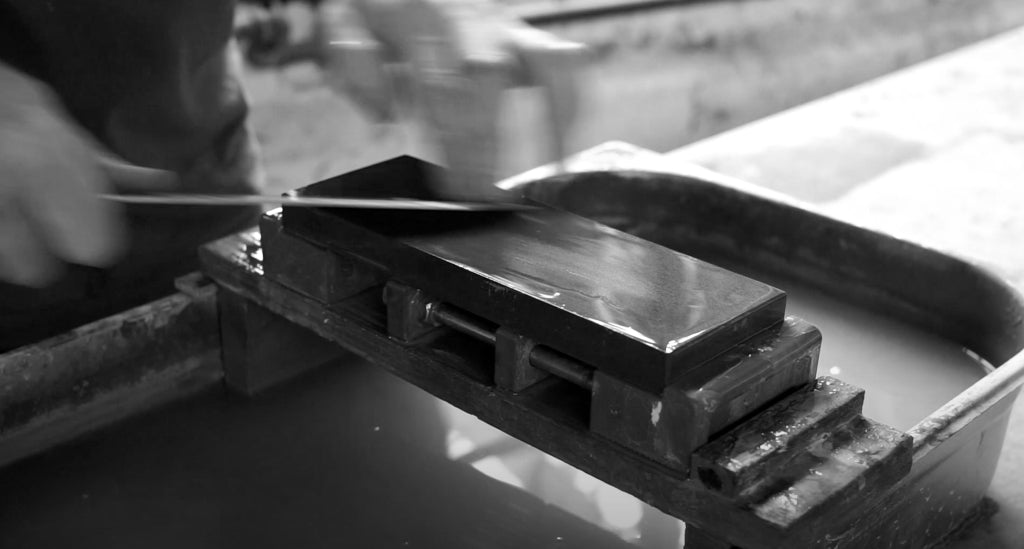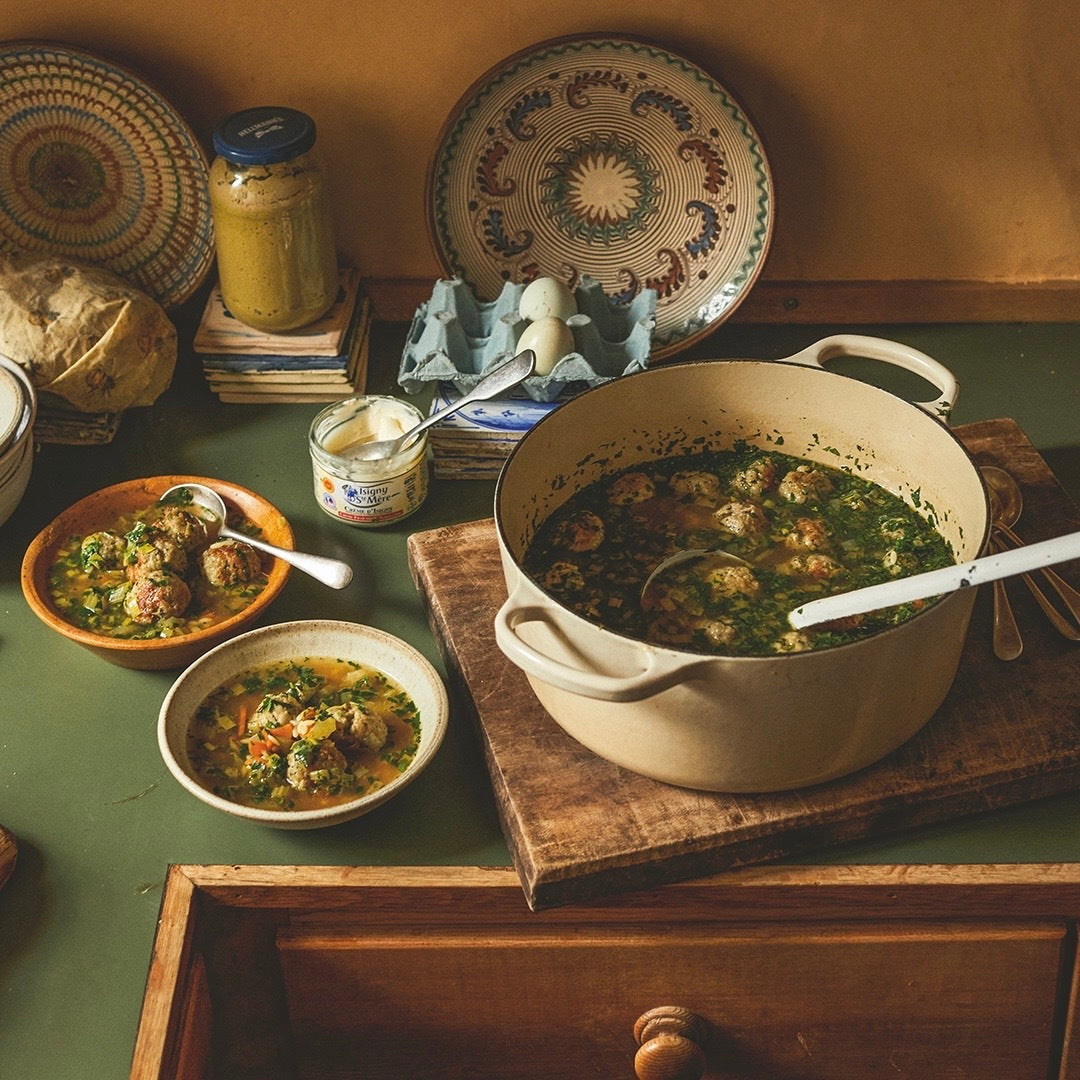Scott McLellan runs Sheffield Knife Sharpening, based in Sheffield, U.K.
He provides TOG's knife sharpening and repair service and works entirely by hand using high quality Japanese whetstones. I wanted to discover his journey into knife sharpening and quiz him on what tips he had for our readers.
I hope you find his answers inspiring as well as interesting.
Bert


Tell us about yourself and what you do?
I work full time out of my workshop, sharpening, repairing and restoring an array of bladed tools. I specialise in sharpening single and double bevel Japanese and high carbon chef knives. I use the highest quality natural and synthetic stones from Japan. Each edge is hand refined to produce the sharpest and most durable finish to best suit the customers needs.
I offer a postal knife repair and sharpening service, as well as local pick up and drop off, and on site sharpening services in professional and domestic kitchens. I run sharpening classes too which some people see as a conflict to my business but it’s part of everything I do. I enjoy sharing the skills that I have picked up over the years. The more people who know how to look after their tools at home the better. I’m still here for them if it all goes wrong, or for those who haven’t got the confidence to try for themselves.
I really enjoy the restoration part of my job. Taking something that looks like it was found at the bottom of the ocean and transforming it back to a useable tool is hugely satisfying. I enjoy saving something from being thrown away and making it functional and beautiful again. I’ve even worked with a few swords over the past year or two. I restored several swords for one chap that have been passed down through generations of his family which were over 200 years old.
The perception of a knife sharpener is somebody who can just put an edge on a knife but there is much more to it than that. To properly look after a blade I’ve learned how to thin and reprofile, repair, and spent time understanding the different type of blades. It’s a skill to be able to repair and sharpen any blade put in front of you as some repair in very different, weird and wonderful ways.
I enjoy sharing the skills that I have picked up over the years. The more people who know how to look after their tools at home, the better.
Many knife sharpeners have electric grinding machines and travel around sharpening knives in one or two minutes. What is your approach to sharpening a knife?
Everything I do is done on stones, synthetic or natural, and mostly Japanese. This is my position because you can pretty much do anything to any knife on a stone. With a machine you are limited. You are dictated by the angles of the machine. There is no set formula that will work for every knife – every single knife is different. With a stone I can change angles, change the shape of the stone if I need to; I can change the grits and each stone does something slightly differently. I switch up stones for different knives.
There are a few downsides to the various machines and grinders that are out there – they generally don’t sharpen a knife instead they put a new bevel on the knife. They take away steel rather than refining it. They don’t give you the polished finish and refined edge that you get with whetstones. Whetstones are really the only way to achieve the level of results that I can achieve.
When sharpening a knife, you don’t sharpen it at the exact same angle across the entirety of the blade. As you get towards the tip you need to raise the angle slightly to take into account the curvature of the edge. A lot of grinders don’t do that. They sharpen it at the same angle all the way along and you end up with a really, really thin tip which makes it more prone to cracking and chipping. The main issue that I have with grinders is that it’s not water cooled. What sets a knife apart from another piece of steel is that it is heat treated – it is a hardened steel. If you apply heat to a hardened steel it makes it soft again. There’s been so much testing done by amazing knife makers and engineers about what is the best method to sharpen and grind blades, and the overwhelming recommendation is water cooled grinding and sharpening. A lot of these machines don’t have the capacity for water, so you’ll always have the risk of overheating the blade which makes it soft and that’s really hard to fix.
So a machine will sharpen a knife quickly but makes it dull very quickly too. The appeal of the machines is the speed and cost per knife, but the downside is that you are removing life from the knife. Machines remove quite a lot of metal each time so the blade will become smaller and smaller over time. The more steel that is removed the less time the knife will last. With a whetstone so little steel is removed that even I can’t measure it.
Whetstones are really the only way to achieve the level of results that I can achieve.
Explain how you got into kitchen knives and sharpening?
I’d never really heard of whetstones before I got into sharpening. I’m a massive foodie, l love cooking and being in the kitchen and making nice stuff. I’d always had an interest in knives, more outdoor knives, as I worked in the marketing department for an outdoor company for years and have always loved wild camping. That fuelled my passion for food and cooking.
I fancied owning a Japanese knife because they are the best in the world. After lots of research I got a little bit daunted. There was so much information out there about how you should look after a Japanese blade and sharpen it. It was overwhelming. I was intimidated by the amount of maintenance that it would need so I put off buying the Japanese knife. I didn’t want to spend loads of money on a knife to then ruin it. After a while all the knives I had in my kitchen had become really dull. So I thought that if I could learn to sharpen the knives that I currently had then I might stand more of a chance to look after a Japanese knife. So I bought myself some super, super cheap whetstones online and tried to teach myself using YouTube. I spent a couple of weeks trying to sharpen my knives at home and it just wasn’t happening; they were getting blunter if anything. So I stuck the whetstones in my cupboard and forgot about them.

Then a few years later I discovered a guy in America, Peter Nowlan, who’s got an Instagram account with sharpening tutorials. I liked the way he explained everything. So I took my whetstones out of the cupboards again and within a few weeks of following his instruction I started to get my knives sharp. That’s where it all started – that moment of realisation that I could sharpen my own knives. It was at that point that I bought a really nice Japanese knife (a Masakage Yuki Gyuto, carbon core with stainless cladding) and treated myself to a proper Japanese stone as well (a King or a Naniwa 1000/6000 combi stone). Then it was instant. The first sharpening was like nothing I had ever experienced. With a good knife and a good stone it blew me away and made such a difference. I couldn’t understand why I hadn’t been able to get results like that before. I went back to the cheap stones and they were really soft and muddy and I couldn’t achieve the same results at all; and they were much harder to use. They just don’t compare to a Japanese stone. Japanese blades are often a lot thinner than Western blades so are typically easier to sharpen as there is less steel to remove and less steel in contact with the stone. With that new stone and new knife it was a game changer for me and changed my perception of what knives were and what sharpening meant. I’d never experienced a Japanese blade and being able to sharpen it successfully was really rewarding and satisfying.
That’s where it all started – that moment of realisation that I could sharpen my own knives.
I then got really obsessed with buying more stones. I started increasing the grit to make my knife sharper. I got more engrossed with the journey of sharpening until I ran out of knives so I started sharpening for neighbours, family and friends. When I started sharpening for other people then the real passion for the sharpening process really ignited. I knew my knives inside out, but when you’ve been given someone else’s knife that you’ve never seen before, and it’s got a whole host of problems that you need to work out, it’s like solving a puzzle. It just made me want to sharpen more and more. Knives when they lose their edge are not knives any more, they lose their identity. The transformation from a blunt tool to something amazing became an obsession.
With a good knife and a good stone it blew me away and made such a difference.
I enjoy the whole process – everything from learning about the different steels and the types of knives and bevels and geometries. I love spending time practising on the stones and doing different tests and working with knife makers and knife brands like TOG Knives. I love everything about where I’m now at with my sharpening journey.
Do you think people need to know all that to have a go and get results?
Absolutely not. I didn’t know any of that when I first started. I was getting really great results before I knew this other world of sharpening even existed. I enjoyed keeping my tools sharp. Like for me, out of curiosity and passion it may well turn into something more, but you don’t need all this extra information to start sharpening and to look after your knives at home.
What advice do you have for people who have never sharpened a knife before?
I’d advise not to buy the super cheap stones from Amazon because although they will get the job done, it’s a longer journey and makes it more difficult. It is a skill, so when you are trying to learn something new you don’t want to make life harder for yourself right at the beginning.
Get yourself a decent knife and don’t be afraid to practice on an expensive knife.
The best thing you can do is to jump in the deep end and go for it really. It’s very difficult to do a very bad job using whetstones. The worst you’ll do is blunt your knife and that’s very easy to recover from. What you’re not going to do is ruin a knife like you would do with a grinding machine. Remembering this will take some of the apprehension out of the process.
Get yourself a decent knife and don’t be afraid to practice on an expensive knife.
Practice and patience are two of the most important things. When starting out take your time and don’t rush.
Being able to keep a constant angle is critical. Don’t get too hung up at being at the perfect or a specific angle. Some people get really, really obsessed about sharpening at a particular degree. It’s more important to try and hold a constant angle across the whole length of the blade. You should raise it ever so slightly towards the tip so the tip doesn’t get too thin.
The formation and removal of a burr is probably the most important element. As you remove steel from one side of the knife the steel will start to fold over the edge of the blade. On the other side you should start to feel a little ridge of steel – it will be very, very small and it can be hard to feel for it at first. Then once you feel it, you flip the knife over and do the exact same thing on the other side of the knife. Then the next important thing is removing the burr. So you need to go backwards and forwards in a stropping motion until the burr breaks off. After you’ve done that with one stone you need to hop on to your next highest grit whetstone and repeat the exact same process. And you can carry on the process with higher grit whetstones. Once you’ve reached where you want to get to on the stones you can then use a leather strop or a very, very high grit stone to polish and refine the edge.

What are the common mistakes people make when they start out and how can they avoid them?
If you are getting frustrated and your knife isn’t getting sharp, the main reasons would be that you are either sharpening at too high or too low an angle. If you sharpen at too high an angle it creates an obtuse angle which doesn’t get the blade as sharp as it should. If you sharpen at too low an angle you’re probably not hitting the apex of the edge. When you start you can use a clip on angle guide which gives you an indication of what sort of degree you should be hitting. I’m not a massive fan of angle guides but they come in really handy at the beginning of the journey. It’s like riding a bike with stabilisers; it gives you the feeling of being safe and upright. Once you get used to forming a burr I recommend removing the angle guide and learning to do it freehand and get more of a feeling of how the knife should be sharpened.
The other common mistake is people trying to do too much or too little too soon. The nicest stones to sharpen with are the higher grit stones; they feel really good. You feel like you’re really sharpening a knife on a 3000 or 6000 stone. But if you don’t spend enough time on the low grit stone, allowing time to raise and remove the burr, you’re not really going to do a great job once you get to the higher whetstones. So, once you master getting a sharp knife on a low whetstone it’s a breeze on a high stone.
You can also spend too long sharpening. If you try to do the entire process in one go when you first start it can be quite fatiguing. If you feel like you are getting a bit frustrated with it and it’s taking a long time just take a break and pick it up again another day. Trying to rush through it will result in making a mess of the edge. Break it into different sessions and learn how to master individual stones first. You are trying to take on a lot of information, pick up lots of new skills and your muscles are working in a new way, so it’s important to break it up to make it manageable.
What whetstone would you recommend for someone just starting their sharpening journey?
A good quality medium (1000) grit is the most versatile and you can do pretty much anything with it. You can achieve a really lovely, useable, durable edge with a 1000 grit stone. If you go too high it’s going to take you ages to raise a burr on a dull knife, and if you go too low you might not get the refined edge that you might be expecting. If you can get a knife really sharp on a 1000 grit then it’s a great place to start. You should be able to get a blade to easily cut magazine paper or shave hair off your arm with it. I get asked multiple times a week from chefs and home cooks what whetstone grit I recommend and I always say that I’ve got 50 plus stones in the workshop, but only one at home and it’s a 1000 grit. That’s all you need really.
We hope we’ve inspired you to learn how to sharpen your own knives. So what’s next? Check out TOG's range of high quality sharpening products designed to help make sharpening easier, quicker and better. We also have a dedicated area of our site for resources on knife sharpening techniques.
Interviewer: Bert Beagley-Brown
Writer: Katie Bailey




